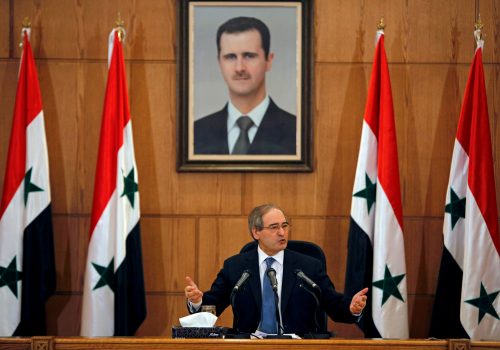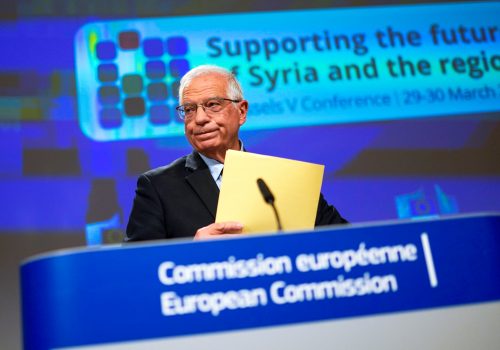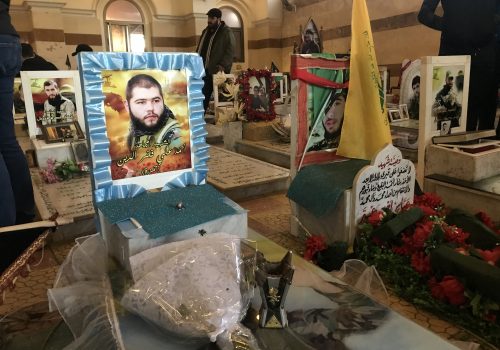Syrian Transitional Military Council: A ‘social media invention’ or much more?
Recent weeks have seen a crescendo of rumors claiming that local, regional, and international support is growing to establish a Syrian Transitional Military Council (TMC). It would allegedly be led by defected Brigadier General Manaf Tlass, whose mandate would be to midwife the war-ravaged nation into a post-Bashar al-Assad future.
The concept of a Syrian TMC has existed for some years. I’ve been told by senior opposition figures that the idea was proposed on at least two previous occasions—2012 and 2016—and that it would be modeled somewhat on the Egyptian experience, following the ousting of Hosni Mubarak in 2011, which saw the Supreme Council of the Armed Forces take the reins of state authority. However, in the case of Syria, forming a TMC has remained a largely comatose idea within diplomatic circles, as the brutality of the fratricidal conflict and the anemic international consensus-building has stifled its materialization.
However, reportage has suggested that the times are changing. According to an article published on February 10 in the London-based Arshaq Al-Awsat, President Assad’s chief foreign patron and post-conflict kingmaker, Russia, received a proposal from members of the exiled opposition for building a Syrian TMC. The article claimed that figures from the Cairo Platform had presented the plan to Russian Foreign Minister, Sergei Lavrov. The Cairo Platform is a group based in the Egyptian capital. Their goal is to facilitate a political transition in Syria but are generally more accommodating to Russia’s position than the Turkey-based opposition.
Nevertheless, soon after the article’s publication, Jamal Suliman, a former Cairo platform-affiliated official, released a statement in which he attempted to set the record straight by saying that he had pitched the proposal to Lavrov in a personal capacity—not as a member of the Cairo Platform. Notwithstanding, media rumors continued thereafter claiming that concerted efforts were being made behind closed doors to establish and institutionalize the Syrian TMC. Allegedly, the favorite to lead the body is Assad’s childhood friend, former regime insider, and General of the elite Republican Guard, Manaf Tlass, who defected and fled to Paris in July 2012 when Damascus’ knees were buckling under the weight of an increasingly capable insurgency.
Some reports say that enthusiasts of the Tlass-led TMC have taken Syrian journalist Yaser Badawi’s published article endorsing the concept in Russian daily Nezavisimaya Gazeta as evidence of the Kremlin’s receptiveness toward the most recent iteration of the idea. Indeed, as the Arshaq al-Awsat article reads, “Opposition figures interpreted Russia’s publication of his [Badawi’s] article as a sign that it was officially prepared to discuss this idea.”
Others have piled on the hype elsewhere. Egyptian Al-Ahram’s Bassel Oudat claimed that the concept “is winning widespread support in Syria,” while the regime’s opponents in exile, such as former rebel leader Captain Ammar Al-Wawe, emphatically asserted that the council’s emergence is “inevitable” in interviews. Reportedly, the raison d’etre of the TMC structure is to oversee movement toward the implementation of United Nations Security Council Resolution (UNSCR) 2254, which, in essence, calls for a nationwide ceasefire followed by Syrian-led United Nations supervised elections as part of a broader political settlement to the conflict.
It does not appear to be outside of the realms of rationality that—given the realities he now faces in Syria—Russian President Vladimir Putin may be willing to bestow his blessing upon the TMC to chart a course out of what appears to be a hardening stalemate. After all, the funds necessary to rebuild Syria, which would allow Russia to move its intervention toward a long-term, enduring strategic victory, are neither being granted by the Western allies nor most of the Arab Gulf states, who demand the end of Assad’s leadership as a prerequisite. Therefore, it appears that there is just enough empirical and theoretical justification to ask: is an effort being made behind closed doors between stakeholders to the Syrian conflict, with the indispensable interest of Moscow, to breathe life into the Tlass-led TMC—or are the reports largely based on rumor?
Brigadier General Talal Farzat, the head of the Free Officer’s Movement and a close confidant of General Tlass, explained to me that the TMC project has recently “received US-Russia consensus and support from the neighboring countries of Syria and the Arab axis.” Pressed on what kinds of concrete signs exist to support this, Farzat, keeping details vague, told me that “Manaf Tlass is on the scene” and has “received serious signals from the local and international levels to crystallize the project and bring it to light.”
Specifically, Farzat further alleged serious and ongoing interaction with the plan by the United States, European Union, Russia, and multiple Arab states. He claimed that the current absence of public declarations of support should not be confused with a lack of growing behind-the-scenes’ endorsement. “The external parties monitor the proposal but prefer not to express open opinions on it yet,” Farzat said, adding that, for now, “they believe that this helps the idea to circulate at the different levels in a calm and deliberative way.” Regionally, Qatari and Saudi officials have expressed the keenest interest in the proposal and are “feeling the pulse” of Syrian opposition entities toward the idea, Farzat told me.
Indeed, a critical ingredient to making the TMC a reality is unity between the men behind it and the military-political actors on the ground—namely the Syrian Interim Government, the Syrian National Army (SNA), and the US-backed Syrian Democratic Forces (SDF). Touching on this, Farzat alleged that “real indications of wide international support” have helped to encourage acceptance of the initiative by “Syrian parties on the ground.”
Yet, these claims are problematized by opposition members I spoke with “on the ground,” all of whom unanimously refuted the idea of the TMC, either denying its political feasibility or outright dismissing it as the product of rumor. One very senior official from the SIG angrily remarked that “We, in the Syrian Interim Government, and in the corps and formations of the Syrian National Army, no one asked us about this project, and we have no role or any position in it at all. The Manaf Tlass project does not receive any support from the Syrian opposition, and 98 percent of the Syrians who support the opposition do not accept…the so-called military council.”
One Idlib-based General from the SNA echoed the point, saying, “this talk [of the TMC] is just opinions spread in social media forums, there is no agreement with anyone.” Continuing the theme, another SNA General from the Hama Military Council scolded the project as “rumors and bubbles from people who like to appear as if they are significant to Syria’s future—they live in Europe and they enjoy collecting likes on social media.” In contrast, the US-backed SDF appear much more accommodating. A high-ranking official from the group informed me that there have been “communications between Manaf Tlass and the SDF regarding the idea and how it will be implemented, we support it.” However, revealing the embryonic phase of the TMC, the spokesman added that, “so far, they have been basic discussions. There is a need for more talks and more clarification on the idea and how it’s going to be implemented.”
Yet, even if the architects of the TMC were to find themselves in a perfect-world scenario, where the gamut of Syrian opposition groups closed ranks behind them, one burning question remains: how to begin the transition from Assad? Beyond asserting that the dictator must leave office in line with UNSCR 2254, the individuals behind the project that I spoke to were either unable or unwilling to elaborate in further detail on how they would go about removing him; whether through some kind of political agreement or by force.
The key to the process would unavoidably be a Russian willingness to abandon Assad. Realistically, the chances of that look scant, with Moscow throwing its weight behind Syria’s upcoming so-called elections (slated for May 26), which will almost certainly grant the Syrian president another term in office,. Underscoring this, an anonymous Barack Obama-era official who worked as an advisor on Syrian Political Transition until 2012 noted that, whenever he asks questions about the plans for transitioning from Assad to those involved in the TMC, he “always encounter[s] either a brick wall or a maze of wishful thinking.”
“It’s one thing to create an elaborate structure depicting how Syria might be governed during different phases of political transition,” the former US official said. “It’s quite another, however, to describe how transition itself actually begins.”
Indeed, it appears that, currently, the TMC is largely a theory whose material existence struggles to exceed ink on paper. Significant impediments to its implementation exist, such as dealing with the fate of President Assad and winning the support of the Turkish-backed Syrian opposition who are skeptical of the mainly Europe-based men behind the TMC and General Tlass. This is, of course, not to mention the lack of concrete evidence, beyond Farzat’s claims, that Russia even supports the proposal. However, the former US official did make one remark at odds with those from the Syrian opposition. He said that despite his reservations about the TMC’s viability, “I can assure you, it’s much more than social media invention.”
Matthew Ayton is a PhD researcher focusing on the Syrian war, specifically in the context of US foreign policy and its support for Syrian non-state actors.
Image: A man walks past a banner depicting Syrian president Bashar al-Assad in Douma, outside Damascus, Syria, September 17, 2018. REUTERS/Marko Djurica/File Photo


